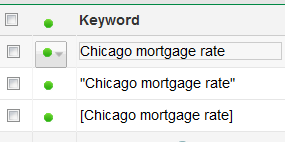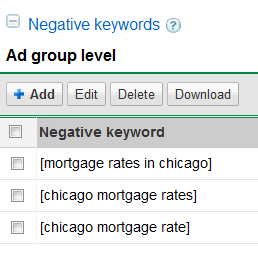3 Simple Strategies For Organizing Your Match Types
When you have two or more keywords that can be triggered in your AdWords account from a search query, Google tries to show the most restrictive option. The constraints go beyond just match type to include geography, time of day, etc. However, Google does not always show exact match over phrase match and phrase match […]
When you have two or more keywords that can be triggered in your AdWords account from a search query, Google tries to show the most restrictive option. The constraints go beyond just match type to include geography, time of day, etc.
However, Google does not always show exact match over phrase match and phrase match over broad match. They also look at ad rank (max CPC x Quality Score). If you have an exact match term bid at $0.25 and the broad match bid at $1, Google will generally show the broad match term.
As an advertiser, you will likely find that your exact match converts higher than your phrase or broad match. You should control the ad serving so you know which ad copy and keyword will be displayed for any search query. You can control the ad serving through the use of bids or negative keywords.
There are several ways your can organize your match types within your paid search account. None of the strategies are better or worse than each other – they are just different. In today’s column, we will examine the three most common match type organizational techniques and show the pros and cons of each.
For each of these scenarios, we will assume you are using multiple match types for the same keyword.
Adding Multiple Match Types To The Same Ad Group
With this method, you add a keyword to an ad group multiple times, each with a different match type.
Pros: The pros of this method is that you have less total ad groups to try and create and optimize. This saves on both creation and management time. If you have a limited amount of time (and/or technology) this is by far the easiest method to use.
Cons: There are several cons to this method. With exact match, you can make a good guess to the user intent of the word, so your ad can be very specific to the keyword. With broad match you know a lot less about the user intent, so you might write a more general ad copy that incorporates the keyword. This method does not allow you to write ads by match types.
The only way to control ad serving with this method is to make sure your exact match is the highest bid, your phrase match the second highest bid, then modified broad match. If your ad rank for your broad match trumps your exact match, then your conversion rates and other data by match types becomes compromised.
Restricting Match Types By Ad Group
With this method, each ad group will only contain one match type. If you want to advertise on both exact match and phrase match terms, then you will have two different ad groups. In addition, for each of your ad groups you will also use negative keywords to ensure the correct match type is being triggered.
For instance, your phrase match ad group will contain exact match negatives of all the keywords.
Pros: There are a few advantages of this method. The first is that the proper keyword match type should be displayed in a search result. You do not have to ensure that your phrase match ad rank is higher than your exact match ad rank (however, it should be as the conversion rates for exact match should be higher than phrase match). This method also allows you to write ad copy by match type.
Cons: The biggest con is that your account can quickly be overwhelmed with too many ad groups to the point that you have to create new campaigns for all of your ad groups as there are hard limits on how many ad groups can be within a single campaign. This method takes a lot longer to setup, and a little bit longer to manage than grouping all of the match types in a single ad group.
Note: It is common to see this method employed where the long tail keywords are grouped by match type into a single ad group, and then the higher priced keywords or higher volume keywords are broken down by match type into different ad groups.
Restricting Match Types By Campaign
Brand that are successful with AdWords have a campaign just for their branded terms. This campaign is often one of the higher budget campaigns because it has the best conversion rates and lowest CPA.
A natural extension of that same logic is that exact match keywords have the second highest conversion rates and second lowest CPAs for most brands. However, there is a limit to how much you can spend on exact match each month based upon search volume. Therefore, you can put all of your exact match in a campaign with a budget to capture all of that search volume.
The next highest conversion rates come from phrase matched words. Group all of your phrase matched words into another campaign. Finally, have yet another campaign for modified broad match and broad match keywords. This last broad match campaign will use the last of the company’s budget.
If the budget gets increased, then the broad match campaign’s budget is often increased. If the budget is being reached, then pull the budget from the broad match campaign which also has the lowest conversion rates of all the campaigns.
When you restrict match types by campaign, you also need to add negative keywords by match type (just like the method restricting match types by ad group) to ensure the proper keywords are being displayed.
Pros: The biggest pro to this account structure is that you can adjust both bids and budget by match types. This method also allows you to write ad copy for each match type and keyword organization.
Cons: The issue with this account structure is that you can quickly have too many campaigns. If you have multiple campaigns by match type, and each ad group only contains keywords of the same match type which cause you to also need more campaigns, and you are doing geographic targeting or the content network, you can quickly become overwhelmed by too many campaigns.
Each campaign must also have a budget. If you slice your budget too thin, then none of your campaigns will receive much traffic. In addition, this method takes more organizational and management time than the other structures. This method is not recommending for smaller budgets.
Conclusion
Each way you organize your keywords and match types has both pros and cons. None of them are better or worse for all accounts.
If you create so many ad groups and campaigns for the perfect organization, but then do not have the time to manage them all and some ad groups or campaigns fall into disrepair, then you should use a time friendlier organization technique.
For very small accounts with little time, organizing match types in the same ad group is just fine. If you have more time than money, and testing is essential to everything you do, then you will want to organize by at least different match types per ad groups, and possibly by campaign.
If you are working with a very large account that is constantly shifting budgets, launching products, and you have moving goal targets, organizing by campaigns is generally the best method to use.
When deciding how to organize your match types and keywords, examine your goals, time, technology, and budget. Map out various scenarios in how to structure your account.
Then, pick the method that will allow you to attain your goals within the time you have to manage your account. A proper account structure is key to the long term success of managing and growing a successful paid search account.
Contributing authors are invited to create content for Search Engine Land and are chosen for their expertise and contribution to the search community. Our contributors work under the oversight of the editorial staff and contributions are checked for quality and relevance to our readers. The opinions they express are their own.
Related stories

